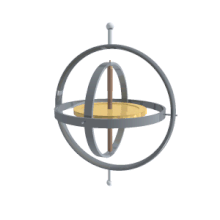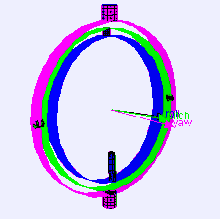Gimbal

A gimbal is a pivoted support that permits rotation of an object about an axis. A set of three gimbals, one mounted on the other with
The gimbal suspension used for mounting compasses and the like is sometimes called a Cardan suspension after Italian mathematician and physicist Gerolamo Cardano (1501–1576) who described it in detail. However, Cardano did not invent the gimbal, nor did he claim to. The device has been known since antiquity, first described in the 3rd c. BC by Philo of Byzantium, although some modern authors support the view that it may not have a single identifiable inventor.[1][2]
History


The gimbal was first described by the Greek inventor Philo of Byzantium (280–220 BC).[3][4][5][6] Philo described an eight-sided ink pot with an opening on each side, which can be turned so that while any face is on top, a pen can be dipped and inked — yet the ink never runs out through the holes of the other sides. This was done by the suspension of the inkwell at the center, which was mounted on a series of concentric metal rings so that it remained stationary no matter which way the pot is turned.[3]
In
The authenticity of Philo's description of a cardan suspension has been doubted by some authors on the ground that the part of Philo's Pneumatica which describes the use of the gimbal survived only in an
The
After antiquity, gimbals remained widely known in the Near East. In the Latin West, reference to the device appeared again in the 9th century recipe book called the Little Key of Painting' (mappae clavicula).[20] The French inventor Villard de Honnecourt depicts a set of gimbals in his sketchbook (see right). In the early modern period, dry compasses were suspended in gimbals.
Verb form etymology
The word "gimbal" began as a noun. Most modern dictionaries continue to list it as such. Lacking a convenient term to describe the swinging movement of a rocket engine, engineers began also using the word "gimbal" as a verb. When a thrust chamber is swung by an attached actuator, the movement is referred to as "gimballed" or "gimballing". Official rocket documentation reflects this usage.
Applications

In inertial navigation, as applied to ships and submarines, a minimum of three gimbals are needed to allow an
In inertial navigation systems, gimbal lock may occur when vehicle rotation causes two of the three gimbal rings to align with their pivot axes in a single plane. When this occurs, it is no longer possible to maintain the sensing platform's orientation.[citation needed]
Rocket engines
In
Photography and imaging

Gimbals are also used to mount everything from small camera lenses to large photographic telescopes.
In portable photography equipment, single-axis gimbal heads are used in order to allow a balanced movement for camera and lenses.
Very large gimbal mounts in the form 2 or 3 axis
Gyrostabilized gimbals which house multiple sensors are also used for airborne surveillance applications including airborne law enforcement, pipe and power line inspection,
Gimbal systems are also used in scientific optics equipment. For example, they are used to rotate a material sample along an axis to study their angular dependence of optical properties.[24]
Film and video

Handheld 3-axis gimbals are used in stabilization systems designed to give the camera operator the independence of handheld shooting without camera vibration or shake. There are two versions of such stabilization systems: mechanical and motorized.
Mechanical gimbals have the sled, which includes the top stage where the camera is attached, the post which in most models can be extended, with the monitor and batteries at the bottom to counterbalance the camera weight. This is how the Steadicam stays upright, by simply making the bottom slightly heavier than the top, pivoting at the gimbal. This leaves the
Powered by three brushless motors, motorized gimbals have the ability to keep the camera level on all axes as the camera operator moves the camera. An inertial measurement unit (IMU) responds to movement and utilizes its three separate motors to stabilize the camera. With the guidance of algorithms, the stabilizer is able to notice the difference between deliberate movement such as pans and tracking shots from unwanted shake. This allows the camera to seem as if it is floating through the air, an effect achieved by a Steadicam in the past. Gimbals can be mounted to cars and other vehicles such as drones, where vibrations or other unexpected movements would make tripods or other camera mounts unacceptable. An example which is popular in the live TV broadcast industry, is the Newton 3-axis camera gimbal.
Marine chronometers
The rate of a mechanical marine chronometer is sensitive to its orientation. Because of this, chronometers were normally mounted on gimbals, in order to isolate them from the rocking motions of a ship at sea.
Gimbal lock

Gimbal lock is the loss of one degree of freedom in a three-dimensional, three-gimbal mechanism that occurs when the axes of two of the three gimbals are driven into a parallel configuration, "locking" the system into rotation in a degenerate two-dimensional space.
The word lock is misleading: no gimbal is restrained. All three gimbals can still rotate freely about their respective axes of suspension. Nevertheless, because of the parallel orientation of two of the gimbals' axes there is no gimbal available to accommodate rotation about one axis.
See also
- Canfield joint
- Heligimbal
- Universal joint
- Cardan shaft
- Keyhole problem
- Trunnion
References
- ^ Needham, Joseph. (1986). Science and Civilization in China: Volume 4, Physics and Physical Technology; Part 2, Mechanical Engineering. Taipei: Caves Books Ltd. Page 229.
- ISBN 1-4020-5598-6.
- ^ a b c d Sarton, George (1959). A History of Science: Hellenistic Science and Culture in the Last Three centuries B.C. Cambridge: Harvard University Press. pp. 349–350.
- ^ Carter, Ernest Frank (1967). Dictionary of Inventions and Discoveries. Philosophical Library. p. 74.
- ISBN 978-3-540-30169-1.
- ISBN 978-0-313-31342-4.
- ^ Needham, Joseph. (1986). Science and Civilization in China: Volume 4, Physics and Physical Technology; Part 2, Mechanical Engineering. Taipei: Caves Books Ltd. p.233.
- ISBN 978-0520214842.
- ^ Needham, Joseph. (1986). Science and Civilization in China: Volume 4, Physics and Physical Technology; Part 2, Mechanical Engineering. Taipei: Caves Books Ltd. pp.233–234.
- ^ Needham, Joseph. (1986). Science and Civilization in China: Volume 4, Physics and Physical Technology; Part 2, Mechanical Engineering. Taipei: Caves Books Ltd. p.234.
- ^ Needham, Joseph. (1986). Science and Civilization in China: Volume 4, Physics and Physical Technology; Part 2, Mechanical Engineering. Taipei: Caves Books Ltd. pp.234–235.
- ^ Needham, Joseph. (1986). Science and Civilization in China: Volume 4, Physics and Physical Technology; Part 2, Mechanical Engineering. Taipei: Caves Books Ltd. p.236.
- ^ Hill, D. R. (1977). History of Technology. Vol. Part II. p. 75.
- ^ Carra de Vaux: "Le livre des appareils pneumatiques et des machines hydrauliques de Philon de Byzance d'après les versions d'Oxford et de Constantinople", Académie des Inscriptions et des Belles Artes: notice et extraits des mss. de la Bibliothèque nationale, Paris 38 (1903), pp.27-235
- ^ Sarton, George. (1959). A History of Science: Hellenistic Science and Culture in the Last Three centuries B.C. New York: The Norton Library, Norton & Company Inc. SBN 393005267. pp.343–350.
- ISBN 978-0-521-79297-4.
- ^ Lewis, M. J. T. (1997). Millstone and Hammer: the Origins of Water Power. pp. 26–36.
- .
- ^ Athenaeus Mechanicus, "On Machines" ("Peri Mēchanēmatōn"), 32.1-33.3
- ^ Needham, Joseph. (1986). Science and Civilization in China: Volume 4, Physics and Physical Technology; Part 2, Mechanical Engineering. Taipei: Caves Books Ltd. pp.229, 231.
- ^ "3-Axis Handheld GoPro Gimbals". gimbalreview.com. GimbalReview. 2017. Retrieved 7 May 2017.
- ^ "Article". Soviet Journal of Optical Technology. 43 (3). Optical Society of America, American Institute of Physics: 119. 1976.
- ^ Dietsch, Roy (2013). Airborne Gimbal Camera – Interface Guide.
- S2CID 115286364.
External links
 Media related to Gimbals at Wikimedia Commons
Media related to Gimbals at Wikimedia Commons
